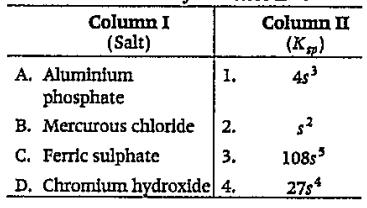Match the rate law given in column I with the dimensions of rate constants given in column II and mark the appropriate choice.
(A) (iv), (B) (iii), (C ) (ii), (D) (i)
(A) (i), (B) (ii) (C ) (iii) ,(D) (iv)
(A) (iii), (B) (ii) (C ) (i) ,(D) (iv)
(A) (ii), (B) (i), (C ) (vi), (D) (iii)
The correct Answer is:D
Topper's Solved these Questions
- BOOK - NCERT FINGERTIPSCHAPTER - CHEMICAL KINETICSEXERCISE - MCQs3videos
CHEMICAL KINETICS
- BOOK - NCERT FINGERTIPSCHAPTER - CHEMICAL KINETICSEXERCISE - Integrated Rate Equation25videos
CHEMICAL KINETICS
- BOOK - NCERT FINGERTIPSCHAPTER - CHEMICAL KINETICSEXERCISE - Assertion And Reason15videos
CHEMICAL KINETICS
- BOOK - NCERT FINGERTIPSCHAPTER - BIOMOLECULESEXERCISE - Assertion And Reason15videos
BIOMOLECULES
- BOOK - NCERT FINGERTIPSCHAPTER - CHEMISTRY IN EVERYDAY LIFE EXERCISE - Assertion And Reason15videos
CHEMISTRY IN EVERYDAY LIFE
Similar Questions
Match species given in Column I with the electronic configuration given in Column II.
Column IColumn II(a)cr(i)[Ar]3d84s0(b)Fe2+(ii)[Ar]3d104s1(c)Ni2+(iii)[Ar]3d64s0(d)Cu(iv)[Ar]3d54s1(v)[Ar]3d64s2View SolutionMatch the salt in Column I with its relation for Ksp in Column II in terms of solubility s in mol L−1.
 View Solution
View Solution
Knowledge Check
- Question 1 - Select One
Match the bond enthalpies given in column II with the molecules given in column I and mark the appropriate choice.
Column IColumn II (A)Hydrogen (H2)(i)498.0 kJ mol−1(B)Oxygen(O2)(ii)946.0 kJ mol−1(C)Nitrogen(N2)(iii)435.8 kJ mol−1A(A)→(i),(B)→(ii),(C)→(iii)B(A)→(iii),(B)→(ii),(C)→(i)C(A)→(i),(B)→(iii),(C)→(ii)D(A)→(iii),(B)→(i),(C)→(ii) - Question 2 - Select One
Match the bond enthalpies given in column II with the molecules given in column I and mark the appropriate choice.
Column IColumn II (A)Hydrogen (H2)(i)498.0 kJ mol−1(B)Oxygen(O2)(ii)946.0 kJ mol−1(C)Nitrogen(N2)(iii)435.8 kJ mol−1A(A)→(i),(B)→(ii),(C)→(iii)B(A)→(iii),(B)→(ii),(C)→(i)C(A)→(i),(B)→(iii),(C)→(ii)D(A)→(iii),(B)→(i),(C)→(ii) - Question 3 - Select One
Match the column I with column II and mark the appropriate choice.
Column IColumn II(A)Fe(OH)3(i)Ksp=s2(B)Ag2CrO4(ii)Ksp=27s4(C)CH3COOAg(iii)Ksp=108s5(D)Ca3(PO4)(iv)Ksp=4s3A(A)→(iii),(B)→(ii),(C)→(iv),(D)→(i)B(A)→(ii),(B)→(iv),(C)→(i),(D)→(iii)C(A)→(i),(B)→(iii),(C)→(ii),(D)→(iv)D(A)→(iv),(B)→(i),(C)→(iii),(D)→(ii)
Match species given in Column I with the electronic configuration given in Column II.
Column IColumn II(a)cr(i)[Ar]3d84s0(b)Fe2+(ii)[Ar]3d104s1(c)Ni2+(iii)[Ar]3d64s0(d)Cu(iv)[Ar]3d54s1(v)[Ar]3d64s2View SolutionFrom the rate expression for the following reactions determines the order of reaction and the dimensions of the rate constant.
a) 3NO(g)→N2O(g)+NO2(g) , Rate =k[NO]2
b) H2O2(aq)+3I−(aq)+2H+(aq)→2H2O(l)+I−3, Rate =[H2O2][I−]
c) CH3CHO(g)→CH4(g)+CO(g) : Rate = k[CH3CHO]3/2
d) CHCl3(g)→Cl4(g)+HCl(g) : Rate = k[CHCl3][Cl2]1/2
e) C2H5Cl(g)→C2H4(g)+HCl(g), Rate =k[C2H5Cl]View SolutionFrom the rate expression for the following reactions, determine their order of reaction and the dimensions of the rate constants:
(i) 3NO(g)→N2O(g),Rate=k[NO]2
(ii) H2O2(aq)+3I−(aq)+2H+→2H2O(l)+I−3,Rate=k[H2O2][I−]
(iii) CH3CHO(g)→CH4(g)+CO(g),Rate=k[CH3CHO]3/2
(iv) C2H5Cl(g)→C2H4(g)+HCl(g),Rate=k[C2H5Cl]View SolutionColumn-I(Order)Column-II(Unit of rate constant)(a)Zero(p)L2mol−2s−1(b)First(q)Lmol−1s−1(c)Second(r)molL−1s−1(d)Third(s)s−1
View SolutionMatch the column I with column II and mark the appropriate choice.
Column IColumn II(A)Fe(OH)3(i)Ksp=s2(B)Ag2CrO4(ii)Ksp=27s4(C)CH3COOAg(iii)Ksp=108s5(D)Ca3(PO4)(iv)Ksp=4s3View Solution

